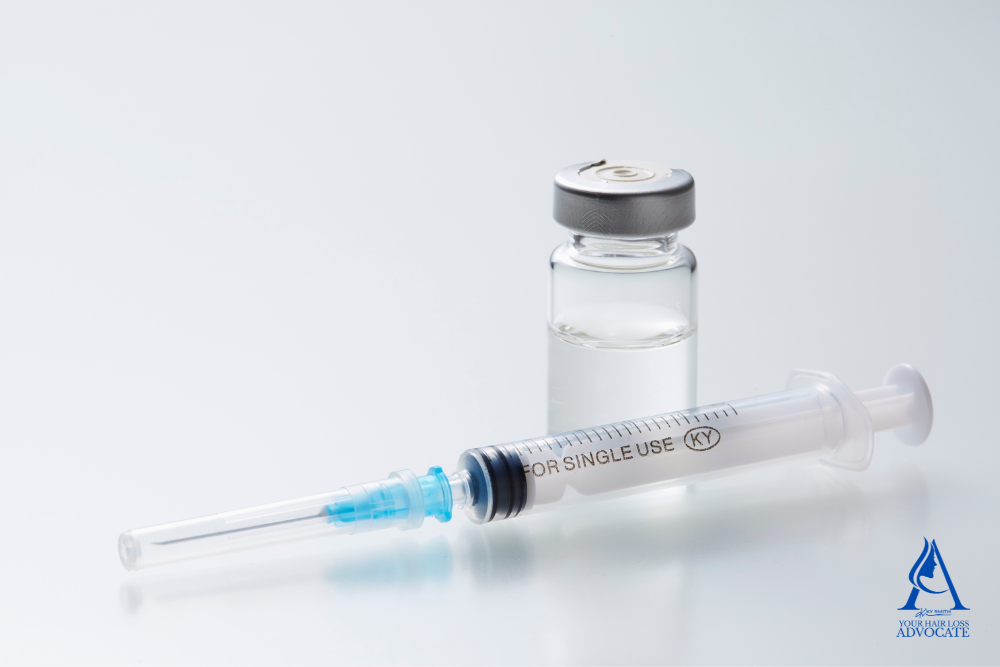What Your Dermatologist Never Told You About Those Shots — And Why You’re Left Worse Off
She sat under the bright light of the exam chair, desperate and exposed. Her dermatologist told her the same thing thousands of women hear every year:
“Let’s do steroid injections to calm this down. It’s just inflammation. We’ll tackle it right at the source.”
Multiple injections. At once. Every few weeks. And for a while, it seemed like it worked. The redness on her scalp lessened, some patchy spots even started to fill back in. She finally exhaled. Maybe this was over.
But months later, she’s back where she started — only now it’s worse. Her scalp feels even more reactive. New areas are thin, tender. The dermatologist has no answers. And she’s stuck wondering whether the very thing she hoped would save her hair might have made the entire problem spiral.
If you’re reading this, and you’re the woman who’s been injected time and again without ever being told what was actually going on, I wrote this for you.
Why They Recommended Those Injections in the First Place
Here’s the part most dermatologists won’t break down:
Corticosteroid injections are designed to be a short-term, high-potency anti-inflammatory. They’re synthetic steroids that suppress local immune activity — basically telling your body “stop attacking here.”
So yes, for conditions like alopecia areata or even inflammatory scalp disorders, they can force a temporary reprieve. The swelling quiets down. The immune signals telling your follicles to shut off production are momentarily silenced.
But silence isn’t resolution. It’s not healing. It’s just quiet.
And that’s where the real deception happens.
The Devil in Disguise: Why So Many Women Get Worse After Steroid Shots
Because once the injection wears off, the underlying driver — the reason your body was inflaming your scalp to begin with — is still fully operational. Only now, it might be more entrenched because you never addressed it.
It’s like shutting off a fire alarm instead of figuring out why your kitchen is filled with smoke.
Multiple studies published on corticosteroid injections show that while they may force temporary improvement, relapse is common — often with even weaker follicles.
- Atrophy of the skin: thinning, dimpling, and loss of supportive tissue
- Follicular miniaturization: where hair grows back weaker, thinner, or not at all
- Telangiectasia: small broken blood vessels on the scalp that compromise circulation
- And ironically, rebound inflammation, often worse than the initial flare.
Most dermatologists don’t prepare women for this. They hand you a quick fix, then shrug when the problem not only returns but escalates.
What They Never Told You: Your Inflammation Didn’t Start on Your Scalp
Here’s the part no one bothered to explain to you — the thing that left you betrayed by your own doctor.
That inflammation on your scalp? It didn’t start there. The shots you were given only muted the local manifestation.
Your body creates its own corticosteroids (like cortisol) in the adrenal glands. They’re your built-in, perfectly regulated anti-inflammatory system. The real question isn’t why your scalp inflamed — it’s why your body’s natural mechanisms failed to regulate it on their own.
- Is your immune system overactive because your gut barrier is compromised?
- Are your adrenals exhausted from relentless life stress?
- Is your liver so burdened by toxins or hormone imbalances that it can’t help process inflammatory byproducts?
- Are micronutrient deficiencies starving your cells of the raw materials needed for normal repair?
Synthetic corticosteroids are far more potent than what your adrenals make naturally, and while they force the local area to quiet down, they never address why your own system isn’t working. That’s why your relief didn’t last. That’s why you’re left with more questions — and more fragile hair — than before.
Why Trust a Functional Trichologist Over a Board-Certified Dermatologist?
I hear this all the time.
“Why would I trust a trichologist over a dermatologist? They’re a medical doctor, after all.”
Let’s be clear: dermatologists are experts at diagnosing diseases of the skin and scalp. They’re trained to name what they see and intervene pharmacologically or surgically.
What they’re not trained to do is investigate systemic physiology, to map out how your gut, liver, adrenals, hormones, and micronutrients are conspiring to make your scalp vulnerable in the first place.
That’s where Functional Trichology comes in — and why I built this discipline from the ground up.
As the innovator of Functional Trichology™ and founder of the American Academy of Hair and Scalp Diseases (AAHSD), I don’t just treat hair. I teach beauty professionals across the country to read the body’s signs, to understand how seemingly unrelated burdens end up showing on the scalp.
Through my Triangle to Recovery™ framework, we pinpoint:
- Where your body’s stress axis is overfiring or under-regulating
- How your gut and liver might be failing to clear inflammatory triggers
- Whether your nutrient and mineral reserves are depleted, compromising cell turnover and immune modulation
- And how your lifestyle patterns have laid the groundwork for exactly where you find yourself now.
Because your scalp is just the canvas. Your systems underneath? That’s the real art we need to restore.
So Where Do You Go From Here?
Maybe you’re sitting there, wondering if you ruined your chances by getting the injections. Maybe you’re scared to try anything else because it all feels like a gamble. And you’re right — most of what’s out there is just noise.
But here’s the truth: your hair loss is not random, and it’s not a simple cosmetic inconvenience. It’s your body’s most visible way of saying “pay attention.”
Suppressing symptoms without understanding why they started only guarantees they’ll come roaring back, often more entrenched. That’s why conventional stats on chronic hair loss show recurrence rates upwards of 50% within a year of stopping medication. The Institute for Functional Medicine also emphasizes that most chronic inflammation originates in systemic imbalances, not simply at the site you see.
Real recovery isn’t about injections or fancy topicals. It’s about building a blueprint that’s calibrated to your physiology — so your body stops seeing your hair as optional.
Ready to Understand What’s Actually Driving Your Hair Loss?
If your dermatologist left you feeling like you were just another script to fill, I promise you — there’s a different way.
Apply for a complimentary 15-minute Follicle Readiness Call.
We’ll determine if mapping a sustainable recovery plan through Functional Trichology is right for you — and if it’s time to finally find out why your hair was sacrificed in the first place.
Because your hair deserves more than crisis management.
It deserves a strategy that restores your health from the inside out — so your follicles have no reason to retreat.

